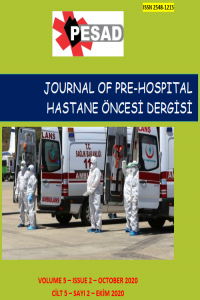HASTANE ÖNCESİ SAĞLIK PERSONELİNİN HİZMET İÇİ EĞİTİMİNDE SİMÜLE HASTA UYGULAMASININ ACİL OLGU YÖNETİMİNDEKİ ETKİNLİĞİNİN DEĞERLENDİRİLMESİ
Amaç: Araştırma, hastane öncesi acil sağlık hizmetleri personelinin hizmet içi eğitim programlarında kullanılan simüle hasta uygulamasının acil olgu yönetimindeki etkinliğinin değerlendirilmesi amacıyla yapılmıştır.
Anahtar Kelimeler:
Simüle Hasta, Acil Olgu Yönetimi, Hastane Öncesi, Ekip Çalışması
EVALUATION OF THE EFFICIENCY OF SIMULATED PATIENT APPLICATION IN EMERGENCY CASE MANAGEMENT IN-SERVICE TRAINING OF PREHOSPITAL HEALTH PERSONNEL
Objective: This study aimed to evaluate the effectiveness of the simulated patient application used in the in-service training programs of prehospital emergency health care personnel in emergency case management.
Keywords:
Simulated Patient, Emergency Case Management, Prehospital, Teamwork,
___
- 29007 sayılı 'Sağlık meslek Mensupları ile Sağlık Hizmetlerinde Çalışan Diğer Meslek Gruplarının İş ve Görev Tanımlarına Dair Yönetmelik'. (22 Mayıs 2014).
- Abelsson, A, & Lundberg, L. (2018). Trauma simulation in prehospital emergency care. Journal of Trauma Nursing| JTN, 25(3), 201-204. Abelsson, A, Rystedt, I, Suserud, BO, & Lindwall, L. (2016). Learning by simulation in prehospital emergency care–an integrative literature review. Scandinavian journal of caring sciences, 30(2), 234-240.
- Adamo, G. (2003). Simulated and standardized patients in OSCEs: achievements and challenges 1992-2003. Medical Teacher, 25(3), 262-270.
- Barrows, HS. (1968). Simulated patients in medical teaching. Can Med Assoc J, 98(14), 674-676.
- Cleland, JA, Abe, K, & Rethans, JJ. (2009). The use of simulated patients in medical education: AMEE Guide No 42. Medical Teacher, 31(6), 477-486. https://doi.org/10.1080/01421590903002821
- Donovan, T, Hutchison, T, & Kelly, A. (2003). Using simulated patients in a multiprofessional communications skills programme: reflections from the programme facilitators. European Journal of Cancer Care, 12(2), 123-128.
- Jeffries, PR, & Rizzolo, MA. (2006). Designing and implementing models for the innovative use of simulation to teach nursing care of ill adults and children: A national, multi-site, multi-method study. New York, NY: National League for Nursing.
- K. Haracz, G. Arrighi and B. Joyce (2015). Simulated patients in a mental health occupational therapy course: A pilot study. British Journal of Occupational Therapy , 78(12),757-766.
- Kitapcioglu, D, Tanriover, O, yıldız, S, Aksoy, M, & Gülpınar, M. (2021). Evaluation of A Simulation-Based Clinical Preparation Program by Final-Year Medical Students: A Qualitative Study on Emergency Patient Management. https://doi.org/10.21203/rs.3.rs-152440/v1
- Kopf, S, Scheele, N, Winschel, L, & Effelsberg, W. (2005). Improving activity and motivation of students with innovative teaching and learning technologies. WIT press.
- Mercan, N, & Ozcan, CT. (2021). The Standardized Patients Application Effectiveness Scale (SAES): A New Scale-Based Measure of Simulated Patient Application Effectiveness. International Journal of Caring Sciences, 14(1), 127.
- Okuda, Y, Bryson, EO, DeMaria, S, Jr, Jacobson, L, Quinones, J, Shen, B, & Levine, AI. (2009). The utility of simulation in medical education: what is the evidence? Mt Sinai J Med, 76(4), 330-343. https://doi.org/10.1002/msj.20127
- Overstreet, M. (2008). The use of simulation technology in the education of nursing students. Nursing Clinics of North America, 43(4), 593-603.
- Perry, P. (2011). Concept analysis: Confidence/self‐confidence. Nursing forum.
- Prion, S. (2008). A Practical Framework for Evaluating the Impact of Clinical Simulation Experiences in Prelicensure Nursing Education. Clinical Simulation in Nursing, 4(3),e69-e78. https://doi.org/https://doi.org/10.1016/j.ecns.2008.08.002
- Sağlık Bakanlığı, (2015). Sağlık Çalışanları Temel Eğitim Kitabı. Sistem Ofset.
- Sheppard, L. (2016). Effectiveness of Standardized Patient Simulation Scenarios on Medication Administration Confidence in Nursing Students. Available at SSRN 3144117.
- Sikon, JR, & Lei, C. (2020). Orientation to the Medical Simulation Environment. In StatPearls. StatPearls Publishing Copyright © 2020, StatPearls Publishing LLC.
- Unver, V, Basak, T, Watts, P, Gaioso, V, Moss, J, Tastan, S, Iyigun, E, & Tosun, N. (2017). The reliability and validity of three questionnaires: the student satisfaction and self-confidence in learning scale, simulation design scale, and educational practices questionnaire. Contemporary nurse, 53(1),60-74.
- Zapko, KA, Ferranto, MLG, Blasiman, R, & Shelestak, D. (2018). Evaluating best educational practices, student satisfaction, and self-confidence in simulation: A descriptive study. Nurse Education Today,60, 28-34.
- Başlangıç: 2016
- Yayıncı: Paramedik Eğitiminde Standardizasyon ve Akreditasyon Derneği
Sayıdaki Diğer Makaleler
CPR MANKENİ ÜZERİNDE KARDİYOPULMONER RESUSİTASYON ETKİNLİĞİNİN SAPTANMASI
Mahmut BELER, İsmail UYSAL, Ali AKGÜN
İlk ve Acil Yardım Programında Okuyan Öğrencilerin Uzaktan Eğitime Yönelik Tutumlarının İncelenmesi
Mehmet ALTUNTAŞ, Galip USTA, Gökhan ERSUNAN, Uçar KÜÇÜK, Abdullah Osman KOÇAK
Şükran BALKANER, Gül Özlem YILDIRIM
Elif KILIÇ GÜNER, Özge AKBABA, Elanur YILMAZ KARABULUTLU, Havva ÖZTÜRK
